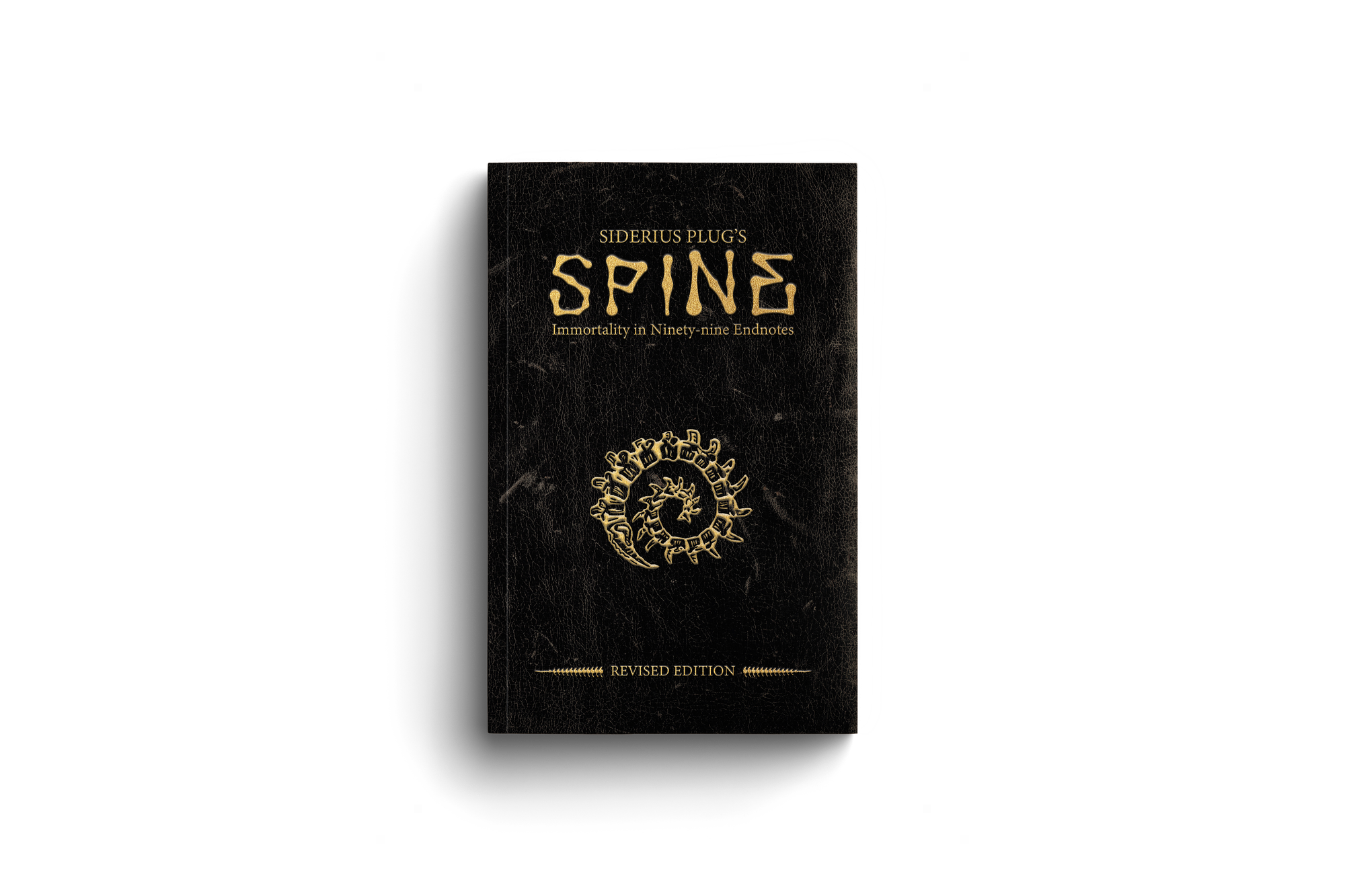SPINE
You're a researcher who has inherited a book from an estranged relative. The book is odd. It’s modern and appears inexpensive. Yet it must have been one of your relative’s most prized possessions, locked behind a thick glass case among her rare books. What’s inside the book is equally strange, a collection of excerpts about eternal life and the magicians who sought it. These excerpts include texts of diverse genres — an essay, biography, diary, and collection of poetry — all by different authors and sewn together at the spine by some obscure scholar.
This book is titled Siderius Plug’s Immortality in Ninety-nine Endnotes. SPINE for short. You feel compelled to read it.

SPINE (Print $9.99)
SPINE is a solo TTRPG that looks like a book. In SPINE, you play as a researcher who has inherited this strange book from an estranged relative. You play by reading the book and following the prompts that you discover in the endnotes. But you soon discover a catch. You are being absorbed by the book — getting lost in it. The only way to lessen its power is by defacing the text.
Piece together the story without losing yourself in it.
What is this game?
In SPINE, you physically embody a researcher who is reading and annotating this book, uncovering its backstory and dredging up old memories through Siderius Plug’s endnotes. But you soon discover a catch. You are enthralled by the book, and the clock ticks down as you realize you are becoming completely absorbed by it. The only way to lessen its power is by defacing the text.
What do you need to play?
The book. A pencil. Your curiosity. A spine…
SPINE is meant to be played with a physical copy. Although I provide a digital version available for download, I recommend printing the booklet version or purchasing a print-on-demand copy.
SPINE is easy to learn. It has only one page of rules. The book takes care of the rest.
Why this game?
In SPINE, you physically embody your character as you uncover their memories, decode the book’s secrets, and manipulate the physical prop that is the book. That is what is so unique about this book: The book is the game, and the game is the book. The book is your anchor to the fictional world. The book is a prop too. And it’s also a keepsake, something that you annotate and draw in as the game progresses.
At the same time, this game seeks to emulate the experience of books like Nabokov’s Pale Fire, books that make you work and play in such a way that blur the lines between fiction and reality, books that force you to work and play with language.
In SPINE, I set out to make a tabletop RPG that insists on language as the backbone of TTRPGs. I set out to make a tabletop RPG that foregrounds the textual nature of the genre, that codifies reading as play, and whose text insists upon itself in a very material way.
What do others say about this game?
“A thoroughly chilling yet engrossing experience. I found myself enthralled by the interconnected mysteries lurking within the pages, until I simply couldn’t put it down. Horror enthusiasts & linguistic puzzlers must explore!” — S. Kaiya J. (Her Odyssey, Galatea, Untitled Moth Game)
Contributors
SPINE features hand-carved block print art by Holly Freiberg, artist of the gorgeous cover of Hellwhalers: Leviathan, and prop creation by the multi-talented Nala J. Wu. Developmental editing was completed by Furt the Goblin.
FAQ
Q: How long does it take to play SPINE?
A: SPINE takes about 4 hours to play. It can take more or less, depending on how much time you want to dedicate to prompts.
Q: Is SPINE replayable?
A: SPINE is replayable. Each book can be played three times. Although the broader plot remains the same, each playthrough has different experiences, and there are many secrets inside this book that you will not uncover in just one or two playthroughs. Some secrets exist outside of play, meant to be discovered only by the most astute readers. And the book’s defacement is designed in such a way that it will survive multiple playthroughs.
Q: Can I read SPINE instead of playing it?
A: SPINE can be enjoyed without engaging with the prompts; however, the prompts are a central part of the play and contribute to future playthroughs and reading.
Q: Is SPINE a journaling game?
A: SPINE's prompts are very diverse and can involve note-taking, drawing, ripping, burning, and more. SPINE has writing prompts too; however, they are typically short notes in the margins from your character's perspective. There are several prompts throughout the course of the book that can involve journaling.
Media
- Solo Bookplay (w/ Asa Donald) on the Yes Indie'd Podcast
- I Read SPINE in Idle Cartulary
- Making a Game of Getting Lost in a Book in Cannibal Halfling Gaming
- Review and Interview for SPINE in The Lone Toad newsletter
- A Review of SPINE by Mint of Theresattrpgforthat
- An Interview with TTRPG Insider
- An Interview with Dan Davenport
